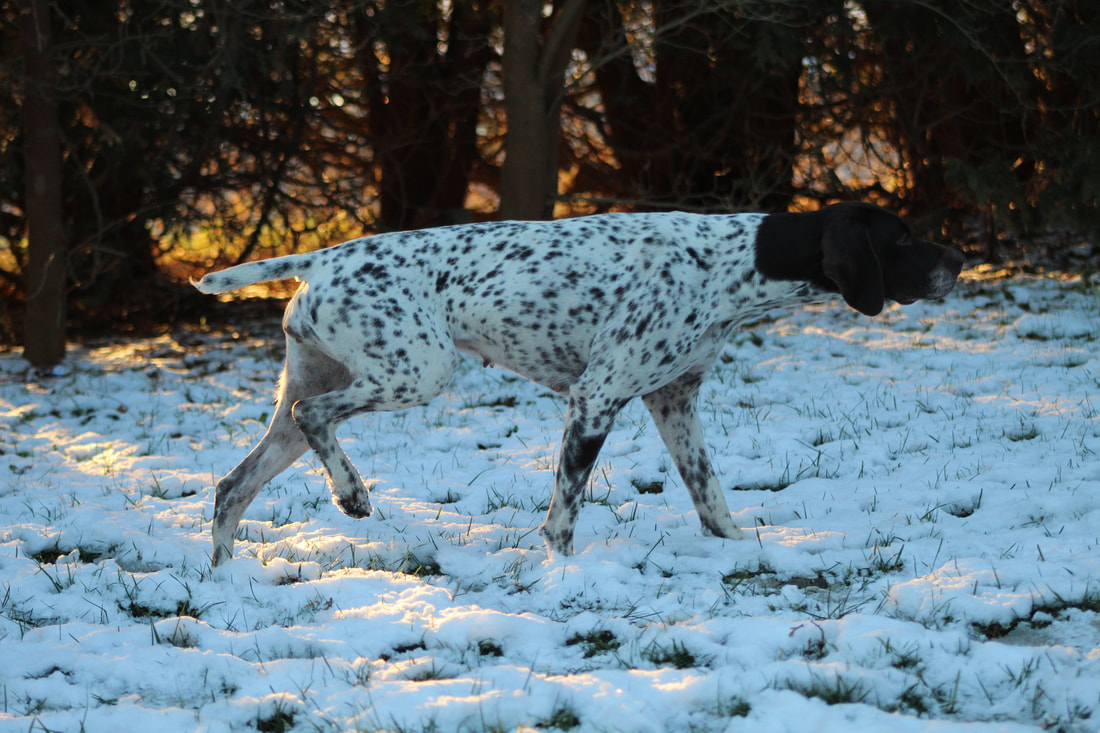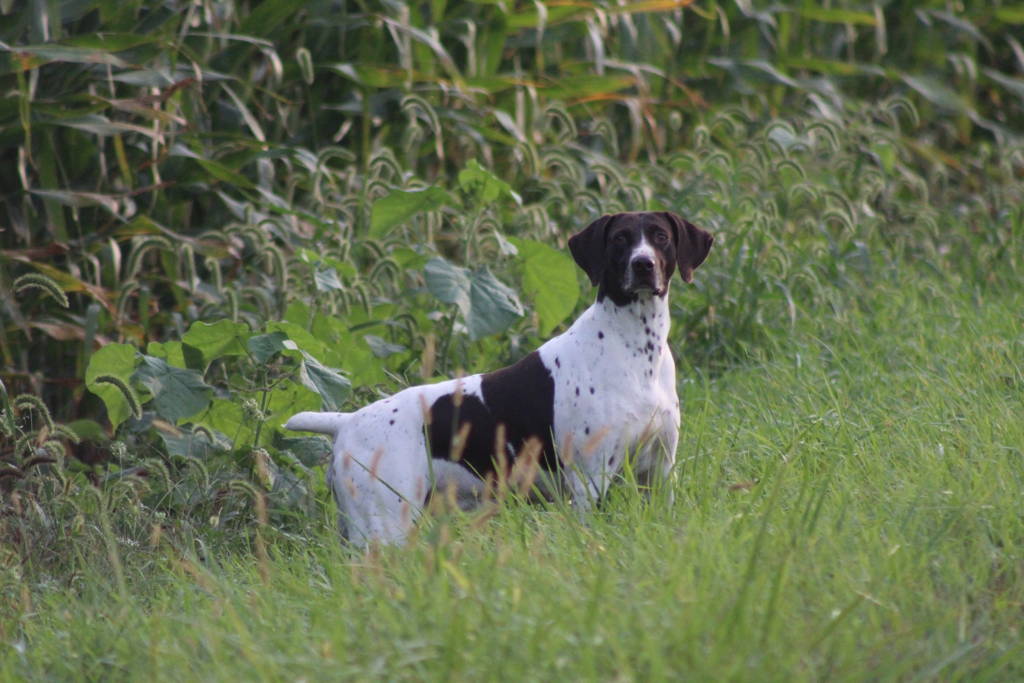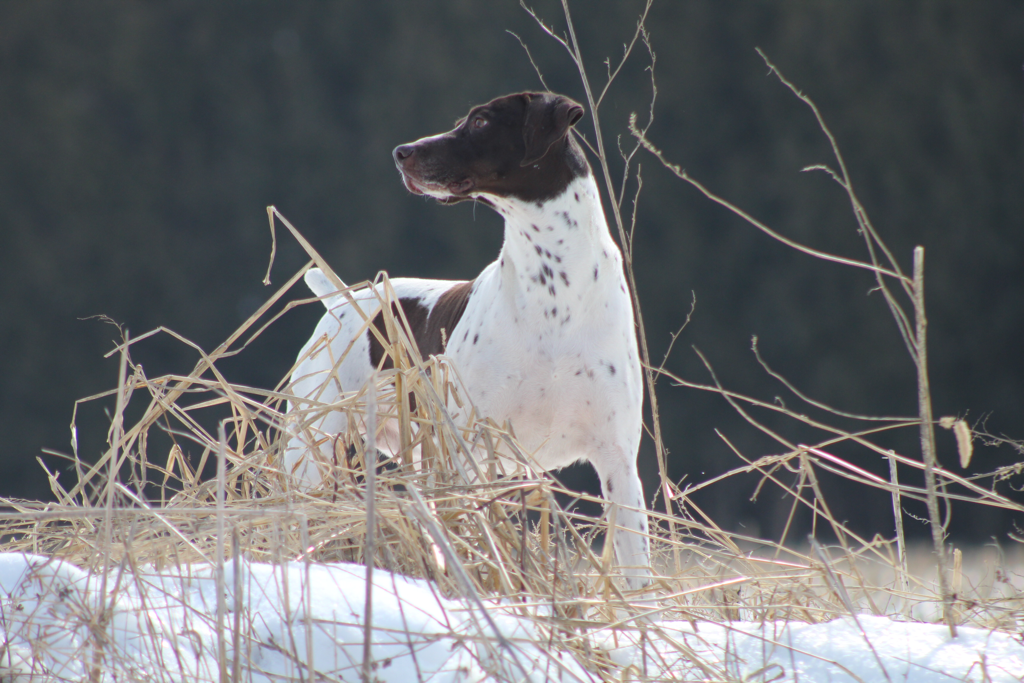German Shorthaired Pointer
Breed Info
|
Basic Info The German Shorthaired Pointer is a versatile Sporting dog bred to be a hunting and multipurpose bird dog. Bred to work the duration of the day in the field with their owners, they are energetic and adaptable - an overall intelligent and independent breed, they are suited for active homes that can meet up with their mental and physical demands.
|
Size and Appearance
|
The German Shorthaired Pointer is a short-haired, medium-sized, Sporting dog. They are aristocratic and well-balanced in their general appearance. The Standard Height is approximately 23-25 inches for males and 21-23 inches for females at withers (an inch over or under standard is permissible), while their weight can range anywhere from 45-70lbs, give or take a little. The GSP's coat is short and dense that is coarse to the touch and very easy to maintain with little to no grooming required, however they do shed fine hairs regularly and are not
|
recommended for those who suffer from severe allergies. Accepted colours are liver and white, solid liver or black and black and white with many forms of markings, patches and ticking differing in each individual dog.
Health and Lifespan
|
The average lifespan of a healthy, well-bred German Shorthaired Pointer is approximately 11-14 years, though this varies between each individual dog and their overall health in general.
While the breed is known to be a relatively hardy one, no breed is disease free and the GSP is no exception. A reputable breeder will work diligently to try and produce sound animals by knowing their lines and completing health clearances on their dogs prior to breeding. A health clearance determines if dog suffers from an illness/disease or is a carrier of a certain genetic issue that the breed is prone to, and is done through OFA - The Orthopedic Foundation for Animals, in conjunction with specialty vets. The required testing for a GSP to receive a CHIC number through OFA is Hips, Elbows, Eyes, Hearts and Cone Degeneration. That said, even with parents having their OFA’s and being clear of these traits it doesn't necessarily mean a puppy won't develop any health issue that the breed is predisposed to. What OFA testing does is offer several generations of health tested and cleared dogs in the family tree with the reassurance of a carefully bred pedigree rather one that hasn't been cleared for anything at all, and knowledge for the breeder to use as a tool in their program. Transparency is important and breeders should be open with health concerns that the breed can be predisposed to and things they have seen or produced. Question those who do not test and especially those who say that they have never produced a concern. There is no such thing as “clear” lines in ANY breed and any breeder that’s bred for a length of time can attest to this. |
Below is a list of health concerns that our breed can be predisposed to:
-Heart Disease -Cancers -Injuries, ligament tears. -Eye Disorders -CD (Cone Degeneration): Fortunately there is an accurate DNA test available. By not breeding two carriers together, we can guarantee that offspring will not be affected. -Epilepsy (Epilepsy is a concern as the GSP is at a higher predisposition to it and there is no genetic testing available to determine a genetic marker that would allow us to avoid it. Two dogs who have never experienced a seizure themselves (and come from non-epileptic parents themselves, etc) can still produce a dog with epilepsy. With no available testing at this time we don’t understand what the genetic marker for epilepsy is, however breeders must not breed affected dogs. |
There are many tests available to be done, so when researching don’t hesitate to ask any breeder you are hoping to get a pup from what tests they do, as a reputable breeder will be happy to go over it with you!
|
Temperament
While the GSP excels in many sports and venues as a versatile breed and is undoubtedly a striking dog to look at, the greatest trait about them is very likely their temperament. They are very much active "family dogs" through and through; their loyalty and affectionate disposition make them velcro dogs. They absolutely Must be apart of the family and your daily life and activities. They crave human interaction and will incorporate themselves fully into your family, bonding with their owner(s) and will want to be with you, going as far as to follow you from room to room. If you're on the computer, they'll curl up under the desk by your feet. If you're in the kitchen, they'll sit next to you and wait for snacks. At night they'll be right there -and with permission- sleep in your bed, curled up next to you. If you don't want a dog who is attached at the hip and is going to be a large part of your daily family life, then don't get a GSP.
That being said, can GSP's do well in a home where their owners work 9-5 day jobs? Yes! They can do well in many situations, given that they get the proper exercise, care and attention needed while you are at home. Look at your schedule and consider if you'll have the time to commit to this active, velcro dog. They are living, breathing animals who need to be fed, exercised, trained, socialized and most importantly loved, so you have to be fair to them and make sure you'll have that time for them for the duration of their lives before adding one into your home. |
They are a very intelligent breed and pick up on things very quickly, however they are also independent thinkers and can have a bit of a stubborn streak, so consistent training is an absolute must! They must understand the rules of the household and what is acceptable. They're incredibly smart, but often when given an inch will try for a mile so consistency is key. With some time and effort you will have a stable, well trained and happy GSP, though keep in mind that they are a very slow maturing breed with a clownish nature, and often times stay puppies at heart for their entire lives, so a sense of humour is a must when living with them. If they don't receive the proper amount of training and exercise, they can become destructive and/or develop other unfavourable habits.
We highly recommend at least one puppy school or basic obedience course.
We highly recommend at least one puppy school or basic obedience course.
|
One thing (and I cannot stress this enough) that every potential new owner or GSP family must be prepared for is that this is an extremely High Energy Sporting Breed that requires lots of daily exercise that is both mental and physical. GSP's are an active breed that can handle working in the fields all day long, going for 10 Km hikes and doing sports such as agility and dock diving, flyball, Frisbee etc... for hours on end - They can keep up with just about every fun activity you throw at them, so you can't expect them to be happy (or even close to satisfied) with a short walk or 10 minute game of ball in the backyard in general every day of their lives.
They need at least 30 minutes to 1+ hour of exercise or time to work every day (both mental and physical stimulation being important) to satisfy their energy requirements. This, of course, will vary from each individual dog who have different energy levels, but be prepared to have a routine for them every day. |
Many owners find fun things to do with their dogs (and there are so many to choose from!), and these things will help your Shorthair get the exercise that he/she needs. A under-exercised Shorthair can get hyperactive and in worse case scenarios, very bored to the point of being destructive. A tired GSP = a happy GSP, which will bring an overall happy household. Now, while a happy, lively and energetic breed they do make fantastic house dogs with the proper exercise! If you live an active life, or feel that with your schedule had enough time to commit to this dog getting the regular activity they need, this may be the right breed for you, and you will have yourself a loyal, fun-loving dog that will be a huge part of your life for many years to come!
|
German Shorthaired Pointer's can do well with kids, other dogs and cats, given that they are socialized with them from a young age. As a general rule we like to say that anything you'll want your GSP around later on, start by getting them used to it when they are puppies. This comes with basic socialization as they grow from puppyhood into adult dogs.
|
With children, it's important to set boundaries early on about what is and is not tolerated. Those boundaries are for both the kids and the dog, so they understand how to interact with each other. The dog should learn that they are not allowed to play rough with the kids (this is a fairly sizable breed that is very energetic, so they can easily, though unintentionally, knock down small children). On the other hand, kids should also understand how to act around the dog. Ear and tail pulling, sitting and jumping on the dog and other behaviours such as this should not be allowed.
|
If you are planning on having your GSP around other animals of any kind at some point in time and aren't going to be raising them together from the time your GSP puppy comes home, then definitely make sure you socialize them plenty with them from the start. We do NOT recommend dog parks as a form of exercise. As people, we don’t love every other human we meet either and we should not expect our dogs to either! Many dogs can be “dog-selective” towards other dogs. Typically, very few dogs actually get along with every other canine they meet. GSP’s can do well in multi-dog environments, but be understanding that not all dogs will be friends. |
To view the German Shorthaired Pointer Breed Standards Please follow the links bellow!
Canadian Kennel Club Breed Standard
American Kennel Club Breed Standard
Canadian Kennel Club Breed Standard
American Kennel Club Breed Standard









